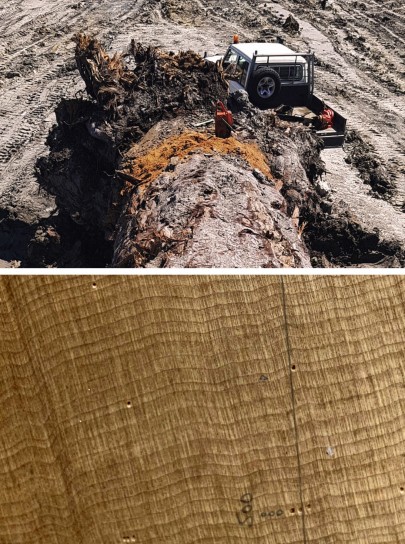Dr Janet Wilmshurst from Manaaki Whenua’s Long-Term Ecology Lab has recently been involved in a number of international collaborations on long term palaeoecological records, resulting in three Science publications this year.
The first paper, Using paleo-archives to safeguard biodiversity under climate change, led by Associate Professor Damien Fordham at the University of Adelaide, provided a review of how palaeoecological records can offer new prospects for benchmarking and maintaining future biodiversity.

Upper photo: Preserved 42,000-year-old kauri log (note truck for scale and saw cut for tree ring data).
Photo: Nelson Parker www.nelsonskaihukauri.co.nz
Lower photo: Tree rings from the saw cut. Photo: Dr Jonathan Parker, UNSW
The team found approximately 40 percent of terrestrial ecosystems are projected to have experienced shifts in temperature during the past 21,000 years that are similar in pace and magnitude to regional-scale future forecasts. The records reveal that terrestrial biodiversity will experience significant changes in response to future global warming, including wide-scale species declines that will threaten the goods and services ecosystems provide to humanity.
Identifying what causes some species to be more sensitive to climate-driven change in the past than others can lead to improving early-warning systems signalling population collapse, extinction or ecosystem shifts as a result of climate change, helping to safeguard biodiversity into the future.
In the second study, A global environmental crisis 42,000 years ago, Dr Wilmshurst and Research Associate Dr Matt McGlone formed part of a major international collaboration between 31 scientists from seven different research fields (geochronology, climate modelling, atmospheric chemistry, solar physics, anthropology, palaeontology and genetics) that examined the impact of the last reversal of the Earth’s magnetic poles.
The researchers analysed radiocarbon (carbon-14) in the tree rings of New Zealand kauri (Agathis australis) logs found preserved in Northland peat bogs for more than 40,000 years. The age of the trees happened to cover a key period of Earth’s history when one of the most dramatic reversals of the magnetic poles occurred 42,000-41,000 years ago, known as the Laschamps Excursion after the French village where it was discovered.
Although the Laschamps Excursion has been recognised in palaeo-archives from around the world, until now it had not been clear whether such magnetic changes had any impacts on climate and life on the planet. Analysis of the ancient kauri tree rings revealed a prolonged spike in atmospheric radiocarbon levels, caused by a surge of cosmic radiation as the Earth’s magnetic field weakened and the poles switched, providing a way of precisely linking widely separated records of environmental change from around the world.
The team found that the changes in magnetic and incoming radiation patterns caused substantial changes in atmospheric ozone concentration and circulation, electrical storms in the tropics, tropical Pacific rain belts and Southern Ocean westerly winds to change abruptly, arctic air to chill North America, and ice sheets and glaciers to advance. These synchronous global climate shifts occurred at the same time as major environmental changes, extinction events, and transformations in the archaeological record.
With some indication that the Earth’s magnetic field could be relatively close to another, similar flip, having weakened c. 9 percent in the past 170 years, this research illuminates some of the possible environmental consequences of such an event.
The third collaboration Dr Wilmshurst was involved with, The human dimension of biodiversity changes on islands, led by Dr Sandra Nogue from the University of Southampton, sheds new light on the impact of humans on Earth’s island biodiversity.
The team studied long-term pollen records dating back 5000 years, extracted from sediments on 27 islands around the world, including from New Zealand. By analysing all these fossil pollen data, they were able to build up an understanding of the composition of each island’s vegetation and how it changed over time.
Globally, islands provide the ideal environment to measure human impact using fossil pollen analysis, as most were settled in the past 3000 years when climates were similar to the present day. Knowing when people arrived on an island means that scientists can study how the composition of its ecosystem changed in the years before and after.
The findings suggested that the rate of change in an ecosystem’s plant-life increases significantly during the years following human settlement, with the most dramatic changes occurring in locations settled in the past 1500 years. The most rapid changes occurred in islands that were settled more recently - such as the Galápagos, first inhabited in the 16th Century. Islands where humans arrived more than 1500 years ago, such as Fiji and New Caledonia, saw a slower rate of change, probably because land-use practices, technology and introduced species brought in by earlier settlers were less transformative and far reaching than those of later settlers.
In New Zealand, and on many other islands, the legacy of human impact almost always surpasses the natural impact of earthquakes, volcanic eruptions, and extreme weather events, and the resulting vegetation changes are often irreversible.
The results of these three Science papers illustrate how reference periods in Earth’s history serve as important natural laboratories for understanding biodiversity responses to climate and anthropogenic change.

